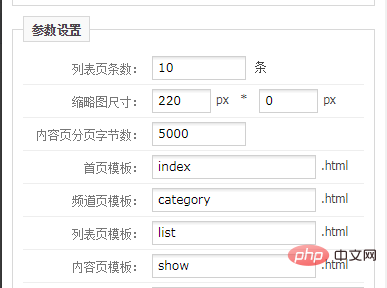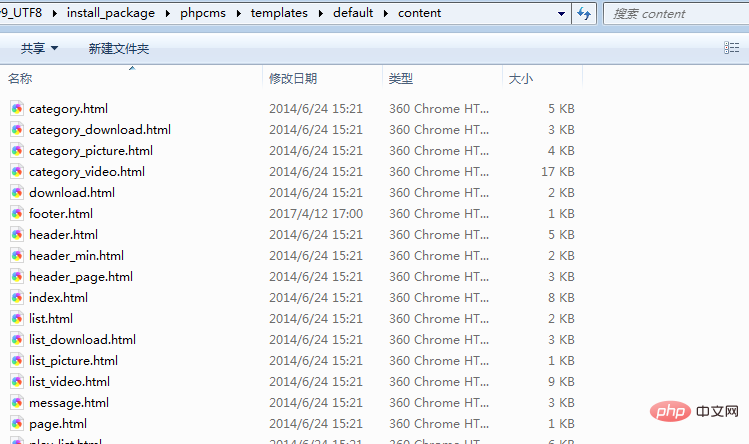PHPCMS v9 如何在手機端欄位綁定模板
- little bottle轉載
- 2019-04-22 09:20:343467瀏覽
前段時間聽朋友說phpcms的手機端,模組是有了,但是有些地方用的還不是很舒服,其中移動端欄目無法綁定模板就不是很方便。如圖,所有的欄位綁定的模板都是固定的。本篇文章主要講述了PHPCMS v9 如何在手機端欄位綁定模板,有需要的朋友可以看一下。

這次咱們就來處理下,行動端如何設定對應的模板。
這裡說是設定模板其實有點偽命題,因為設定模板需要開發不少東西,就像phpcms的欄位那樣,自己選擇模板來綁定,我們這裡為了快速、方便有更簡單的方法。
我們讓行動端的欄位和pc端的欄位綁定一樣的模板,這裡說綁定一樣的模板指的是綁定同樣的模板名字。
phpcms pc端模板路徑 phpcms\templates\default\content 預設的檔案有這些:

如果你pc端的欄位綁定範本規則如下:
圖片category_picyure.html
#美女圖片 list_picture.html㠀 list_picture.html ----->內容頁模板 show_picture.html
那麼移動端的綁定結果如下 \phpcms\templates\default\wap
圖片category_picyure.html
美女圖片 ---->內容頁模板 show_picture.html
帥哥圖片 list_picture.html #---->21/show _picture.html#你需要模板文件,行動端欄位就能自動綁定。
下面是具體的程式碼修改
1、因為行動端首頁範本綁定的是wap\index.html,所以不做修改。
2、打開\phpcms\modules\wap\index.php
在方法lists 中,約47行$template = ($TYPE[$typeid]['parentid']==0 && in_array($typeid ,array_unique($parentids))) ? $WAP_SETTING['category_template'] : $WAP_SETTING['list_template']; 將其註解
# 然後新增程式碼
/
然後新增程式碼
/*$ 'parentid']==0 && in_array($typeid,array_unique($parentids))) ? $WAP_SETTING['category_template'] : $WAP_SETTING['list_template']其跟著pc模板規則走
$setting = string2array($setting);
$template = $setting['category_template'] ?plate +'categoegory_template'] $setting['list_template'] ? $setting['list_template'] : 'list';
$template = $child ? $template : $template_list;
重新組裝資料讓catgory的範本也能使用
if($child){
$catids_str = $arr $catids_str = substr($catids_str, $pos);
$sql = "status=99 AND catid IN ($catids_str)";
*', $offset.','.$pagesize,'inputtime DESC');
$total = $this->db->count($sql);# list = $this->db->select(array('status'=>'99','catid'=>$catid), '*', $offset.','.$pagesize,' inputtime DESC');
}
//重新組裝資料結束
因此category 與list 相同對應的欄位範本。其中數據就是 $list。你可以使用$list進行遍歷。
3、打開\phpcms\modules\wap\index.php
在方法show中約206行$template = $WAP_SETTING['show_template'] ? $WAP_SETTING['show_template'] : 'show '; 將其註解
//$template = $WAP_SETTING['show_template'] ? $WAP_SETTING['show_template'] : 'show';
//處理範本 $ 'setting']['show_template'] ? $CAT['setting']['show_template'] : 'show';
ok 這樣phpcms的行動端就處理完成了!
相關教學:
PHP影片教學
#
以上是PHPCMS v9 如何在手機端欄位綁定模板的詳細內容。更多資訊請關注PHP中文網其他相關文章!

